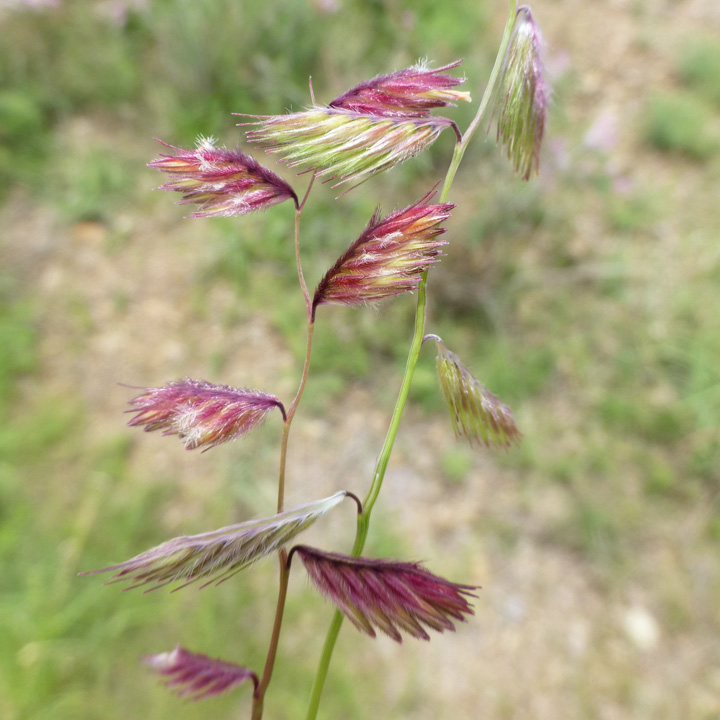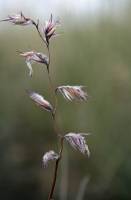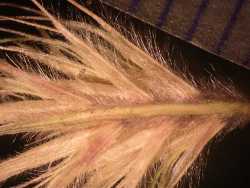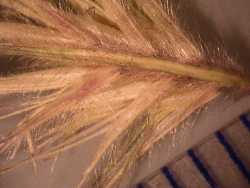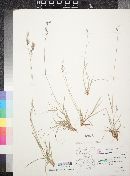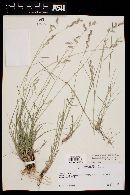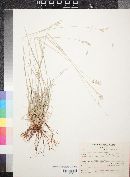|
|
|
|
Family: Poaceae
sprucetop grama
[Chondrosum humboldtianum Kunth, nom. superfl., moreDinebra chondrosioides Kunth] |
Plants perennial; cespitose, without rhizomes or stolons. Culms (10)30-60 cm, erect, unbranched. Leaves mostly basal; sheaths mostly glabrous, margins often long-ciliate distally; ligules 0.3-0.6 mm, of hairs; blades 1-10 cm long, 1-2.5(3) mm wide, flat, glaucous, bases with papillose-based hairs on the margins, similar hairs sometimes present on either or both surfaces. Panicles 2.5-6 cm, with 3-8(10) branches; branches (8)10-15 mm, densely pubescent, with 8-12 spikelets, axes extending to 5 mm beyond the base of the terminal spikelets, apices entire; disarticulation at the base of the branches. Spikelets appressed, all alike, 7-7.5 mm, with 1 bisexual and 1 rudimentary floret. Glumes evidently hairy; lower glumes 2.5-4.5 mm; upper glumes 4.5-6.5 mm; lowest lemmas 4.7-6.2 mm, hairy distally, 3-lobed, lobes unawned or shortly awned; lowest paleas 5-7.2 mm, pubescent along the veins and on the margins, bifid, veins excurrent as short awns; anthers 2.8-4 mm, yellow; upper florets rudimentary, glabrous, 3-awned, awns scabrous, sometimes arising from a short but evident awn column, central awns sometimes with a membranous margin, awns scabrous. Caryopses about 2.5 mm long, about 0.9 mm wide. 2n = 20, 22, 40. Bouteloua chondrosoides grows on dry, rocky slopes and grassy plateaus at 200-2500 m. Its range extends from southern Arizona and western Texas to Costa Rica. It resembles B. eludens in having pubescent panicle branches, but B. eludens usually has 12-16 branches 5-11 mm long with 2-6 spikelets whereas B. chrondrosoides usually has 3-8 branches 10-15 mm long with 8-12 spikelets per branch. FNA 2003 Common Name: sprucetop grama Duration: Perennial Nativity: Native Lifeform: Graminoid General: Tufted perennial grass, stems firm and hard at the base but not rhizomatous, 30-60 cm tall. Vegetative: Sheaths rounded, mostly glabrous, margins often long-ciliate distally; ligules hairy, 0.5 mm; blades glaucous, short, flat, 1-3 mm broad, 1-10 cm long, mostly in a basal clump, not curled, bases with papillose-based hairs on the margins. Inflorescence: Panicle consists of three to seven pectintate spicate branches, each 1 to 1.5 cm long, these borne on the upper 2-6 cm of the stem axis; spicate branches with a flattened, densely hairy rachis and 8-12 closely placed spikelets, deciduous as a whole; all exposed structures of the spikelets more or less hairy; each spikelet with 2 florets, the floret bisexual and the upper floret rudimnetary; fertile lemma three-cleft, the divisions with short awns; rudiment large, the lemma 3-awned, the middle awn broadly winged below. Ecology: Found on dry rocky slopes and rolling desert grassland with fine-textured soils from 2,500-6,000 ft (762-1829 m); flowers August-October. Distribution: se AZ to w TX and south to Costa Rica. Notes: This species is a part of a group of Bouteloua very similar in appearance being perennials with short inflorescence branches (sometimes appearing as clusters of spikelets) on both sides of the axis which are deciduous as a whole, the branches completely falling off and leaving a small nodule behind. Distinguished from the similar B. repens by having pubescence on all surfaces of the spikelets and 3-7 spicate branches (7 - 12 in repens), from B. eludens by having shorter panicles 3-6 cm long (6-10 cm in eludens) and branches with 8-12 spikelets (2 - 6 in eludens) and from B. radicosa by lacking a hard, knotty, rhizomotous base. Ethnobotany: Unknown, but other species in the genus have uses. Etymology: Bouteloua named for brothers Claudio (1774-1842) and Esteban (1776-1813) Boutelou Agraz, Spanish botanists and horticulturalists; chondrosioides means like the genus Chondrosium. Synonyms: Chondrosum humboldtianum, Dinebra chondrosioides Editor: SBuckley 2010, FSCoburn 2014, AHazelton 2015 |


